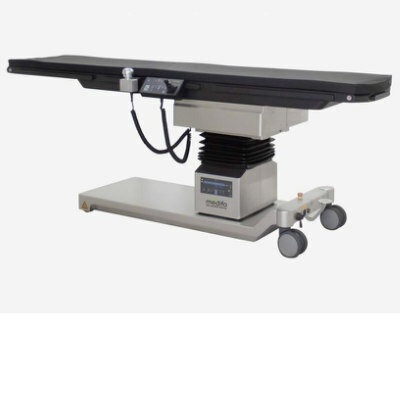RSNA 2022 Showcases Breakthrough Products and Solutions Empowering Radiology
|
By MedImaging International staff writers Posted on 25 Nov 2022 |

The 108th Scientific Assembly and Annual Meeting of the Radiological Society of North America (RSNA, Oak Brook, IL, USA) being held in Chicago at McCormick Place, Nov. 27–Dec. 1 offers attendees the opportunity to experience the latest in medical imaging technology and immerse themselves in the science, education and innovations that keep radiology at the center of patient care. As the world’s largest annual medical imaging forum, RSNA 2022: Empowering Patients and Partners in Care provides attendees with a standout exhibition floor, featuring the latest medical imaging technologies in CT, MRI, AI, 3D printing and more. RSNA 2022 provides attendees, both in-person and virtual, with innovative research and educational opportunities in every subspecialty.
This year’s annual meeting schedule includes 400+ educational courses, 2,500 scientific papers, education exhibits and posters and a highly anticipated line-up of plenary speakers, all delivering the very latest in medical imaging innovation and advancements focused on improving patient care. Sessions include everything from traditional lectures to interactive, hands-on activities that take learning to the next level. RSNA 2022 also includes more networking opportunities and more than 600 exhibitors in the Technical Exhibits halls that are bringing the latest innovations in medical imaging including solutions for teleradiology, cybersecurity, 3D printing and AI. Virtual Access is ideal for those who cannot attend, as well as for attendees who wish to maximize their onsite experience. RSNA 2022 Virtual Access features nearly 100% of annual meeting programming. All attendees registered for Virtual Access can watch the virtual content until May 1, 2023.
The RSNA 2022 Technical Exhibits halls are the ideal setting to engage with industry experts and explore a wide array of medical imaging industry product demonstrations, presentations, workshops and symposiums. With exhibits from over 600 leading manufacturers, suppliers and medical information and technology developers, attendees will be immersed in medical imaging innovation. Visitors can also discover the latest AI solutions and connect with industry experts in the AI Showcase located in the South Hall. The AI Showcase features over 100 companies and provides opportunities for attendees to see the newest AI software and product demonstrations and solutions. Visitors can dive into the hottest topics in AI, machine learning and deep learning in the RSNA AI Theater, and get the training and networking opportunities needed to better understand the role of AI in medical imaging. At the RSNAI Resource Center, located near the AI Theater, visitors can learn about the AI-related resources and educational opportunities provided by RSNA. Attendees can visit the Imaging AI in Practice booth to see demonstrations of new tools and practice enhancements enabled by AI in real-world clinical scenarios. These 30-minute, multi-vendor interoperability demonstrations are showcases new technologies and communication standards needed to integrate AI into the diagnostic radiology workflow.
The 3D Printing & Mixed Reality Showcase located in the North Hall is the place to network with colleagues and industry experts engaged in 3D medical printing research and development. This showcase offers attendees the opportunity to see and interact with the latest products in 3D printing, 3D software and augmented and virtual reality. New this year, the RSNA 3D Special Interest Group (SIG) Showcase offers an opportunity for attendees to share their experiences, innovations and challenges in creating 3D printed anatomical models and guides. This new booth includes a display of 3D models and case studies submitted by institutions that practice 3D printing. This booth offers the opportunity to network with colleagues who are involved in the practice of 3D printing in medicine. This year, RSNA is welcoming 80+ new companies to the First-Time Exhibitor Pavilion. Attendees can connect with these annual meeting newcomers and see their products and services in a showcase area inside the South Hall.
At RSNA 2022, attendees can meet with representatives from educational institutions and leading medical associations from around the world in Educators Row, located in the South Hall. They can also get first-hand experience on an exhibiting company’s proprietary systems by attending user training and product instruction in classroom spaces at Vendor Workshops located within the Technical Exhibits Halls. Industry presentations at RSNA 2022 allow attendees to explore leading-edge products, services and solutions to enhance patient care, streamline operations and learn how to navigate today’s health care landscape. Corporate Symposiums allows attendees to participate in focused one-hour education sessions presented by RSNA exhibitors and sponsors throughout the week. At Innovation Theater, 15-minute live presentations feature the latest imaging innovations from exhibiting companies.
“The RSNA annual meeting provides one of the best opportunities all year to learn about the latest developments in medical imaging research, education and technology from around the world,” said Jorge Soto, MD, chair of the RSNA Annual Meeting Program Planning Committee. “If you’re coming to the meeting, planning to attend virtually or registering for both access options, take time to look at the programming early to get the most out of your experience. Whether you are looking to improve knowledge in your own subspecialty or learn about something new, there is a good chance you will find what you’re looking for at RSNA 2022.”
Related Links:
RSNA
Latest RSNA 2022 News
- Hologic Showcases Comprehensive Breast and Skeletal Health Solutions at RSNA 2022
- Vieworks Exhibits Complete Lineup of Next Generation X-Ray Flat Panel Detectors at RSNA 2022
- Subtle Medical Showcases AI-Powered Imaging Workflow Solutions at RSNA 2022
- PaxeraHealth Demonstrates the Latest in Artificial Intelligence Technology for Imaging at RSNA 2022
- Varex Presents Advances in X-Ray Technology at RSNA 2022
- Radcal Demonstrates Accu-Gold TOUCH Series for X-Ray QA and Service at RSNA 2022
- Agfa Showcases Groundbreaking, Intelligent Solutions That Empower X-Ray Experts at RSNA 2022
- Philips Demonstrates Smart Connected Imaging and Integrated Workflow Solutions at RSNA 2022
- Bayer Highlights Radiology Portfolio and Innovation in AI at RSNA 2022
- Canon Showcases Meaningful Innovation in its Suite of Solutions and Products at RSNA 2022
- Mindray Debuts New Ultrasound Systems and Hepatology Solutions at RSNA 2022
- Siemens Presents Revolutionary High-End MRI Scanners at RSNA 2022
- 4DMedical Debuts Most Advanced Lung Scanning Technology in Decades at RSNA 2022
- KA Imaging Unveils World’s First Integrated Mobile X-Ray System with Dual-Energy Capabilities at RSNA 2022
- AIRS Medical Showcases Award-Winning MRI Enhancement AI Solution at RSNA 2022
- Alpinion Presents New Range of High-Performance Diagnostic Equipment at RSNA 2022
Channels
Radiography
view channel
Novel Breast Imaging System Proves As Effective As Mammography
Breast cancer remains the most frequently diagnosed cancer among women. It is projected that one in eight women will be diagnosed with breast cancer during her lifetime, and one in 42 women who turn 50... Read more
AI Assistance Improves Breast-Cancer Screening by Reducing False Positives
Radiologists typically detect one case of cancer for every 200 mammograms reviewed. However, these evaluations often result in false positives, leading to unnecessary patient recalls for additional testing,... Read moreMRI
view channel
PET/MRI Improves Diagnostic Accuracy for Prostate Cancer Patients
The Prostate Imaging Reporting and Data System (PI-RADS) is a five-point scale to assess potential prostate cancer in MR images. PI-RADS category 3 which offers an unclear suggestion of clinically significant... Read more
Next Generation MR-Guided Focused Ultrasound Ushers In Future of Incisionless Neurosurgery
Essential tremor, often called familial, idiopathic, or benign tremor, leads to uncontrollable shaking that significantly affects a person’s life. When traditional medications do not alleviate symptoms,... Read more
Two-Part MRI Scan Detects Prostate Cancer More Quickly without Compromising Diagnostic Quality
Prostate cancer ranks as the most prevalent cancer among men. Over the last decade, the introduction of MRI scans has significantly transformed the diagnosis process, marking the most substantial advancement... Read moreUltrasound
view channel
Deep Learning Advances Super-Resolution Ultrasound Imaging
Ultrasound localization microscopy (ULM) is an advanced imaging technique that offers high-resolution visualization of microvascular structures. It employs microbubbles, FDA-approved contrast agents, injected... Read more
Novel Ultrasound-Launched Targeted Nanoparticle Eliminates Biofilm and Bacterial Infection
Biofilms, formed by bacteria aggregating into dense communities for protection against harsh environmental conditions, are a significant contributor to various infectious diseases. Biofilms frequently... Read moreNuclear Medicine
view channel
New SPECT/CT Technique Could Change Imaging Practices and Increase Patient Access
The development of lead-212 (212Pb)-PSMA–based targeted alpha therapy (TAT) is garnering significant interest in treating patients with metastatic castration-resistant prostate cancer. The imaging of 212Pb,... Read moreNew Radiotheranostic System Detects and Treats Ovarian Cancer Noninvasively
Ovarian cancer is the most lethal gynecological cancer, with less than a 30% five-year survival rate for those diagnosed in late stages. Despite surgery and platinum-based chemotherapy being the standard... Read more
AI System Automatically and Reliably Detects Cardiac Amyloidosis Using Scintigraphy Imaging
Cardiac amyloidosis, a condition characterized by the buildup of abnormal protein deposits (amyloids) in the heart muscle, severely affects heart function and can lead to heart failure or death without... Read moreGeneral/Advanced Imaging
view channel
New AI Method Captures Uncertainty in Medical Images
In the field of biomedicine, segmentation is the process of annotating pixels from an important structure in medical images, such as organs or cells. Artificial Intelligence (AI) models are utilized to... Read more.jpg)
CT Coronary Angiography Reduces Need for Invasive Tests to Diagnose Coronary Artery Disease
Coronary artery disease (CAD), one of the leading causes of death worldwide, involves the narrowing of coronary arteries due to atherosclerosis, resulting in insufficient blood flow to the heart muscle.... Read more
Novel Blood Test Could Reduce Need for PET Imaging of Patients with Alzheimer’s
Alzheimer's disease (AD), a condition marked by cognitive decline and the presence of beta-amyloid (Aβ) plaques and neurofibrillary tangles in the brain, poses diagnostic challenges. Amyloid positron emission... Read more.jpg)
CT-Based Deep Learning Algorithm Accurately Differentiates Benign From Malignant Vertebral Fractures
The rise in the aging population is expected to result in a corresponding increase in the prevalence of vertebral fractures which can cause back pain or neurologic compromise, leading to impaired function... Read moreImaging IT
view channel
New Google Cloud Medical Imaging Suite Makes Imaging Healthcare Data More Accessible
Medical imaging is a critical tool used to diagnose patients, and there are billions of medical images scanned globally each year. Imaging data accounts for about 90% of all healthcare data1 and, until... Read more
Global AI in Medical Diagnostics Market to Be Driven by Demand for Image Recognition in Radiology
The global artificial intelligence (AI) in medical diagnostics market is expanding with early disease detection being one of its key applications and image recognition becoming a compelling consumer proposition... Read moreIndustry News
view channel
Bayer and Google Partner on New AI Product for Radiologists
Medical imaging data comprises around 90% of all healthcare data, and it is a highly complex and rich clinical data modality and serves as a vital tool for diagnosing patients. Each year, billions of medical... Read more






















